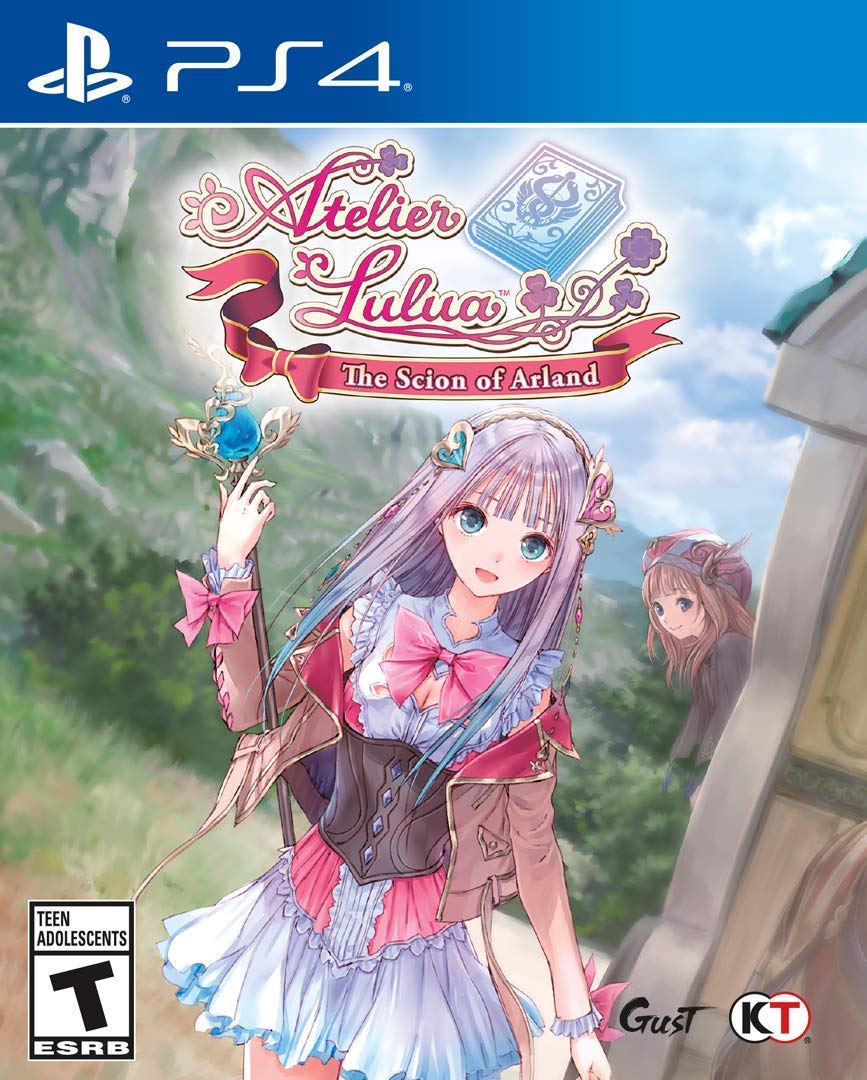Atelier Lulua: The Scion of Arland
Developer: Gust
Publisher: Koei Tecmo
Platforms: PlayStation 4 (Reviewed), Switch, PC
Release Date: Available Now
Price: $59.99 USD – Available Here $89.95 AUD – Available Here
Overview
Fans of the Atelier franchise have come to expect a new game from Gust almost on an annual basis since, at least in the West, a new game has been released every year since 2005 with spin-offs and enhanced releases often doubling that number. This time around however fans are getting an extra dose of Gust’s popular franchise as not only was a spin-off featuring numerous characters from the series released earlier this year, they now have access to Atelier Lulua: The Scion of Arland as well as another new game later this year. Atelier Lulua has quite a name to live up to however as this release now marks the fourth entry in the popular Arland Trilogy but don’t worry if you haven’t played those entries, as newer fans will still find themselves mostly at home here.
Story
Set sometime after the events of Atelier Meruru, though never with a solid year being stated, Rorona has grown up (properly this time) and now has a daughter by the name of Elmerulia Frixell, who everyone simply calls Lulua. Living in the frontier town of Arklys hasn’t changed the fact that Rorona is still extremely busy and well-known, leaving Lulua as a girl that wants to be just like her mother, a great alchemist. The only problem is progress in Lulua’s studies is rather slow and she often fails even the most simple of recipes when not being overseen by her teacher Piana.
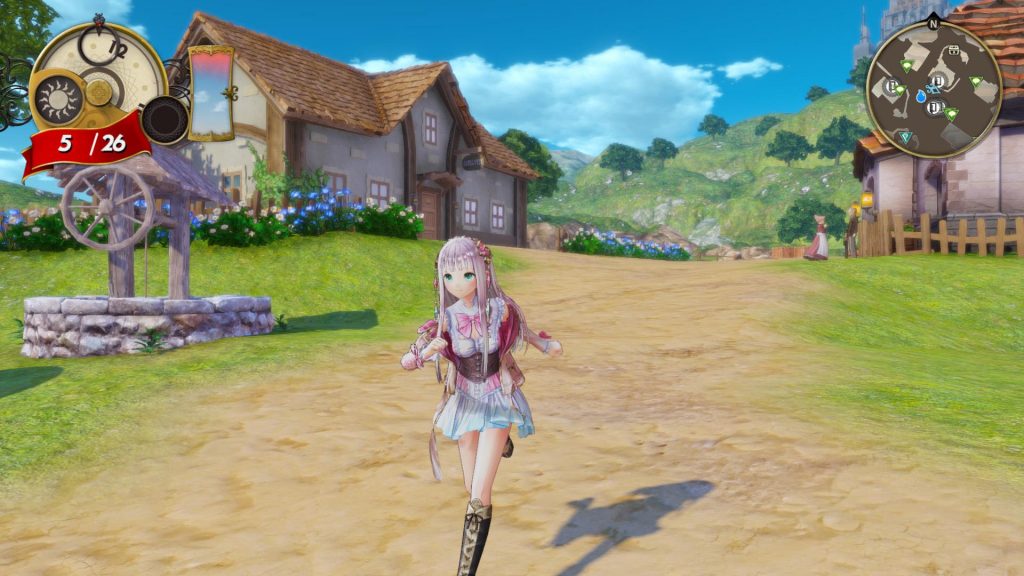
Despite this, Lulua never lets failure get her down and this ends up leading her into a rather dangerous situation that her and her childhood friend Eva barely escape. Only after this does a mysterious artifact, a book called the Alchemyriddle that appears blank for everyone else but shows text for Lulua, do her skills as an alchemist begin to blossom. Through deciphering the cryptic clues the Alchemyriddle provides Lulua’s journey for knowledge explores not only her family life a bit but also reveals more information about the land of Arland itself.
This slightly grander scope than usual helps bridge the gap on some previously unknown knowledge that longtime fans of this trilogy will enjoy and even then the writing is still capable of focusing on the characters themselves as not only is Lulua’s own growth and development given plenty of time to shine, we see numerous other characters from the past make a return in various forms. Of course this means that the story rarely takes on a serious tone but fans of the Atelier series have come to expect a lighter storyline that focuses on character development and interaction and Atelier Lulua delivers rather solidly in that regard.
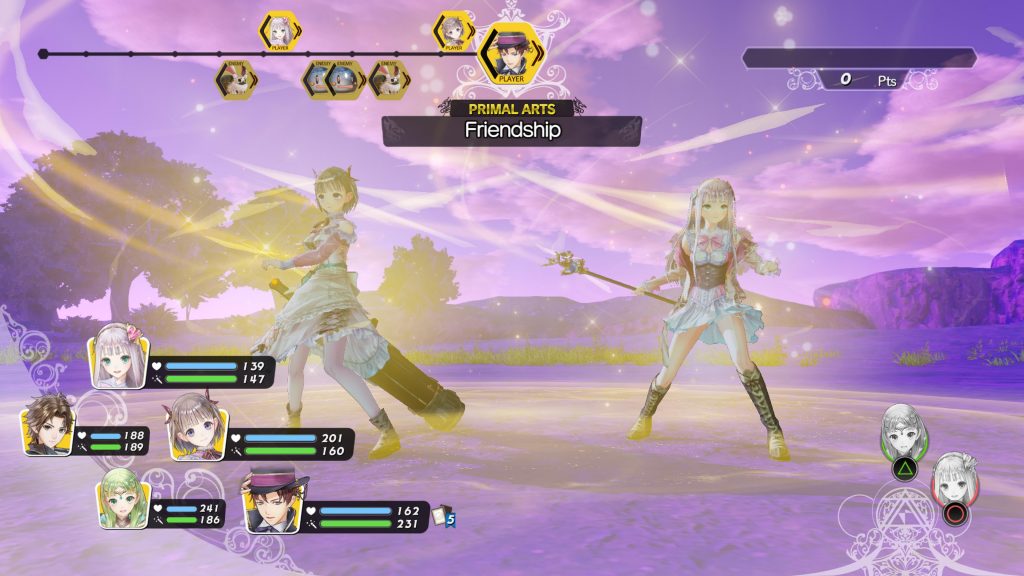
It does feel a bit unfortunate however that despite the fact that Atelier Lulua: The Scion of Arland is the fourth entry in the trilogy that so many of the older cast of characters play smaller roles in this release. Numerous characters from Rorona and Totori make an appearance but their inclusion often feels more like a cameo to please fans and given the surprisingly low number of playable characters in this entry, it feels like a missed opportunity to have more familiar faces be hands on with assisting Lulua besides the three returning characters in the base game. Unfortunately those who want to see Totori or Meruru join the team will need to purchase them extra as DLC. Perhaps this choice of limiting the returning cast is meant to cast more of a light on the fact this is Lulua’s journey and to make newcomers feel welcome, but longtime fans may feel a bit disappointed in that regard.
Gameplay
It is worth noting that although Atelier Lulua: The Scion of Arland returns to the Arland trilogy it does not bring back the time management mechanic that was used throughout those games and instead adopts the more current mechanic that sees time pass while exploring areas, gathering ingredients, fighting, and synthesizing items without having to worry about strict deadlines. Instead most of the progress is instead handled by players tackling the Alchemyriddle. As they make their way through the game the Alchemyriddle will provide a number of clues as to what to actually do next in the form of mini-tasks. These tend to fall into the category of finding a specific location, gathering a specific item, slaying certain enemies, talking to specific characters, or simply synthesizing a proper item.
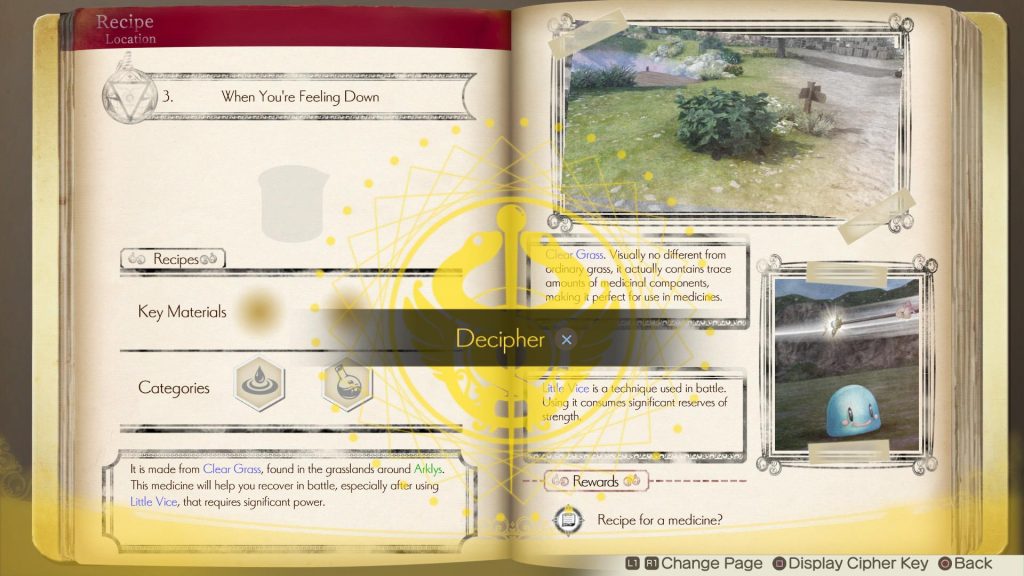
Thanks to these being riddles players will need to figure things out for themselves and they do end up feeling rather challenging further into the game. Unfortunately some of these riddles do feel a bit out of place at times since not every riddle in the book actually progresses the story, there are some that instead offer side-rewards but as to when they can actually be completed when received is often more of a challenge. This can lead to some time being wasted trying to solve a riddle that would be easier to complete further along in the game and while not a major problem it is a bit of an annoyance.
Every good alchemist needs a steady supply of ingredients and the best place to do that is out in the field, which also happens to be where players will be spending most of their time. Lulua and her party will travel through numerous locations where Lulua can gather ingredients from various “gather spots” as well as use various tools to obtain either better or harder to obtain items. These tools fall into the standard of being fishing poles, pickaxes, explosives, and even bug nets with various improvements available for each one of these throughout the game. The areas Lulua can explore are varied enough and considering players often have to revisit areas to locate new items or use a new tool, are rather easy to navigate with there even being an option to skip to a location further in if the player’s already cleared the area.
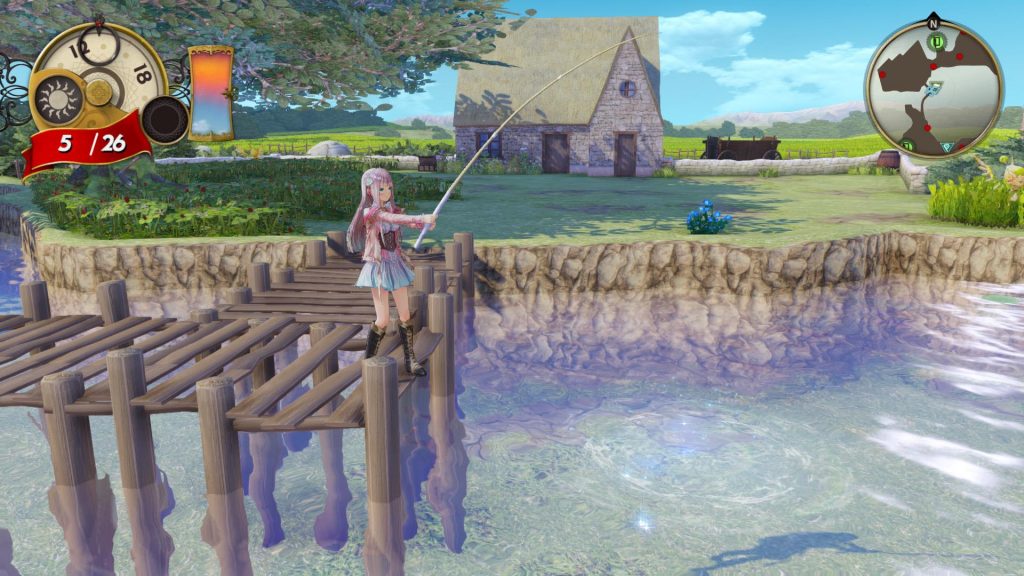
Of course while exploring the land there are a number of threats that will come about where Lulua and her party will need to fight against various monsters. These battles can be triggered simply by touching an enemy on the map or by attacking them ahead of time for advantage. Monster slaying is also a fairly lucrative way to obtain not only experience points for the party but a number of ingredients that can only be obtained in combat. Thankfully the combat mechanics are simple enough to manage and the smaller overall number of playable characters also plays into the fact that combat is handled with three fighters in the front and two support units that can provide various bonuses or swap out with a frontline fighter if need be.
The turn based system is easy to manage as turn order is displayed at the top of the screen with various attacks causing extra time to be spent waiting or push back en opponents turn. It is interesting to note though that Alchemist characters have a bit of extra leeway in this turn order as the “Interrupt” system allows these characters to take an out of turn action using a pre-equipped item. The ability to Interrupt combat charges over time and can play a pivotal role at times as players can use a powerful bomb to defeat an enemy before it unleashes an attack or heal an ally and save them from what otherwise may have been a mortal blow.
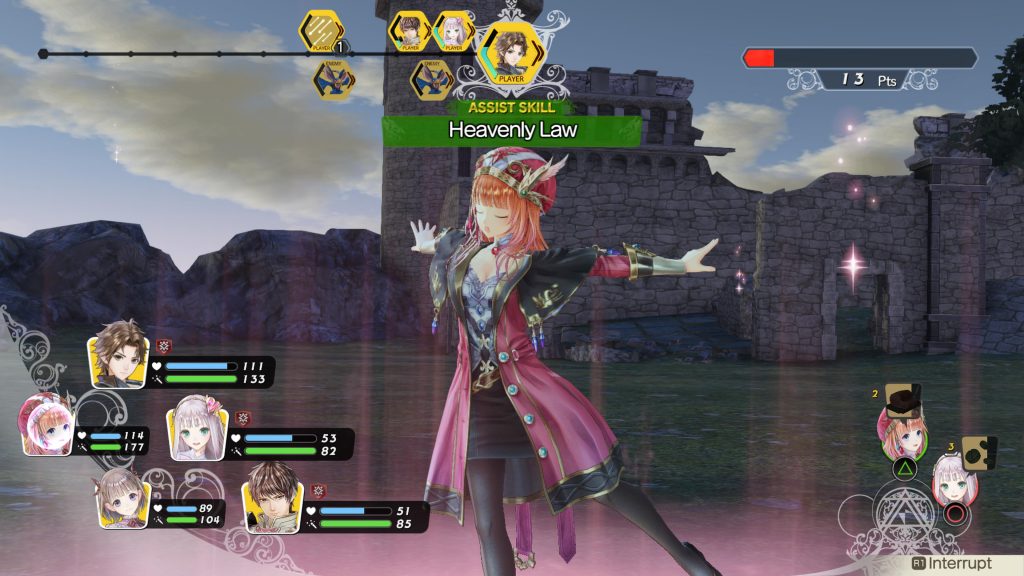
Party synergy also happens to play a unique role in Atelier Lulua as some group members can unlock special buffs when fighting together. These can range from increasing item efficiency to sharing various buffs between each other and even the backline can play a part in this as some units can have special skills trigger under certain circumstances. The amount of combinations available plus the ability to interrupt combat with alchemists keeps Atelier Lulua‘s combat from stagnating, though longtime RPG players may want to up the difficulty a bit for an extra challenge if things feel too easy on normal.
Everything players do out in the wilderness then plays a role when they return to Lulua’s home atelier. Once back at the home base all gathered ingredients can be placed into storage and, while the general carrying capacity is quite high, you’ll want to return fairly often to store items instead of missing out on new materials. The synthesis system in Atelier Lulua remains fairly simple to understand as well as something that can be difficult to master primarily due to the ingredient quality. Every recipe requires a certain number of ingredients that fall into various classes, though a few require a very specific item that cannot be exchanged for anything else. These item classes can range from being fuel, explosives, food, water, etc. and depending on their quality and item type they can play a large role in the quality of the item Lulua will produce.
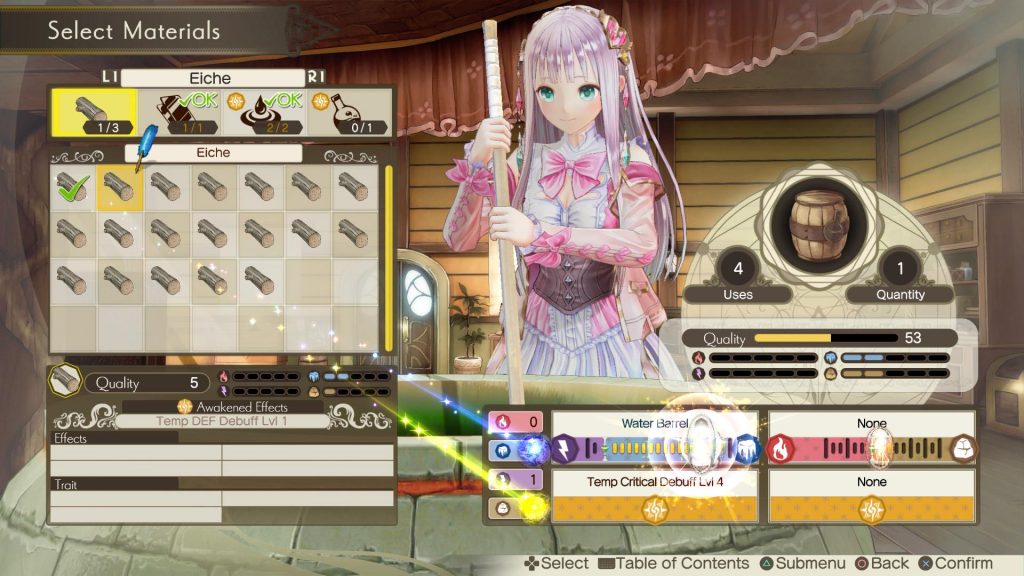
For example, some ingredients can provide fire elements to an item while others may offer earth, though occasionally elements can subtract from one another, thankfully everything is listed prior to actually finishing the product so players can balance out their item choices to best fit their potential goal as certain elemental levels provide additional effects once the item is created. There are even bonus traits that can then be applied once an item is created as well as the ability to awaken hidden traits in some items but this type of nitty-gritty synthesizing isn’t entirely necessary as many items are easily crafted just by selecting the proper ingredients but giving players the ability to really adjust their creations is a great touch to the synthesis system that fans have come to expect from the franchise.
Visuals & Audio
The gorgeous art style that Gust fans have come to know and love stays true in Atelier Lulua: The Scion of Arland as the pastel coloration of the world and many of the characters works wonders for the overall appeal for the game. The characters themselves are also nicely detailed for the series and seeing how returning characters from Rorona and Totori have grown is a welcome treat. The environments players travel through are incredibly diverse and the day and night cycle plays a nice touch at adjusting the enemy spawns in certain locations. Combat can feel like a fairly flashy affair at times since certain items have some great effects when used and some extravagant skills are available as well.
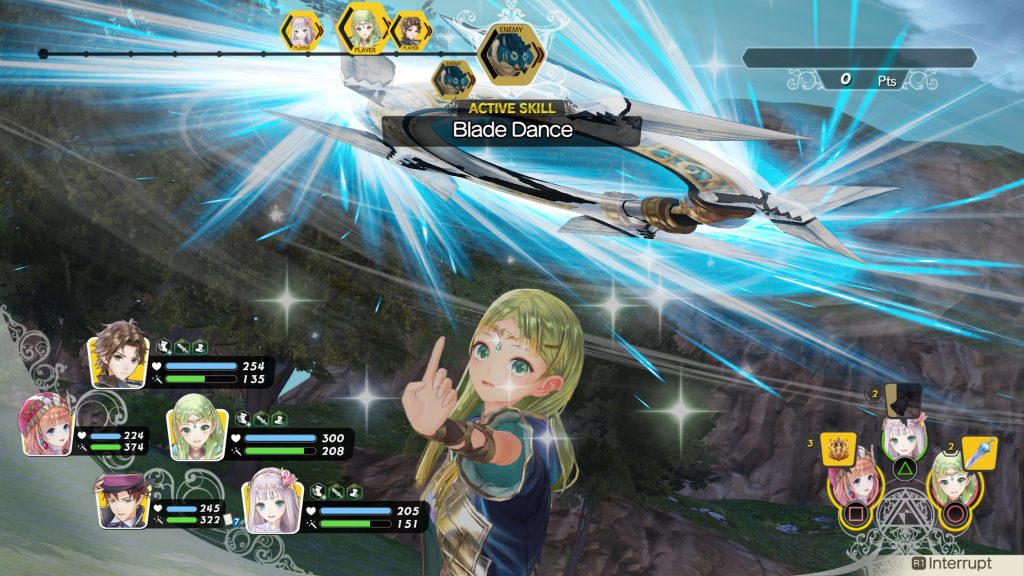
It is worth noting that Atelier Lulua: The Scion of Arland continues the trend of Koei Tecmo not providing an English dub for the game. This may disappoint longtime fans who want to hear their favorite characters in English once more but the Japanese voice cast is a great fit for their roles and thanks to this, nearly every bit of dialogue is voiced. The soundtrack for the series is a calming and familiar set of themes that fans have come to expect though due to this design choice few of the tracks really stand out.
Overall
Atelier Lulua: The Scion of Arland had quite a challenge lying before it as it had to live up to the trilogy that came before it but Gust’s management of the characters and story, as well as various refinements to the synthesis system and changes that keep combat feeling a bit more strategic than before help it meet that hurdle admirably. That being said, the lack of a proper English dub, the occasionally obtuse feeling of the Alchemyriddle’s hints, and the feeling that so much more could have been done with the returning cast of characters from many fans’ favorite trilogy is a bit disappointing however, especially given the minimal number of party members available in the base game. Still, fans of the Atelier series will find that Atelier Lulua once again nails the mark in delivering a comfortable storyline filled with great moments as well as the synthesizing mechanics that players have come to expect.
Capsule Computers review guidelines can be found here.


